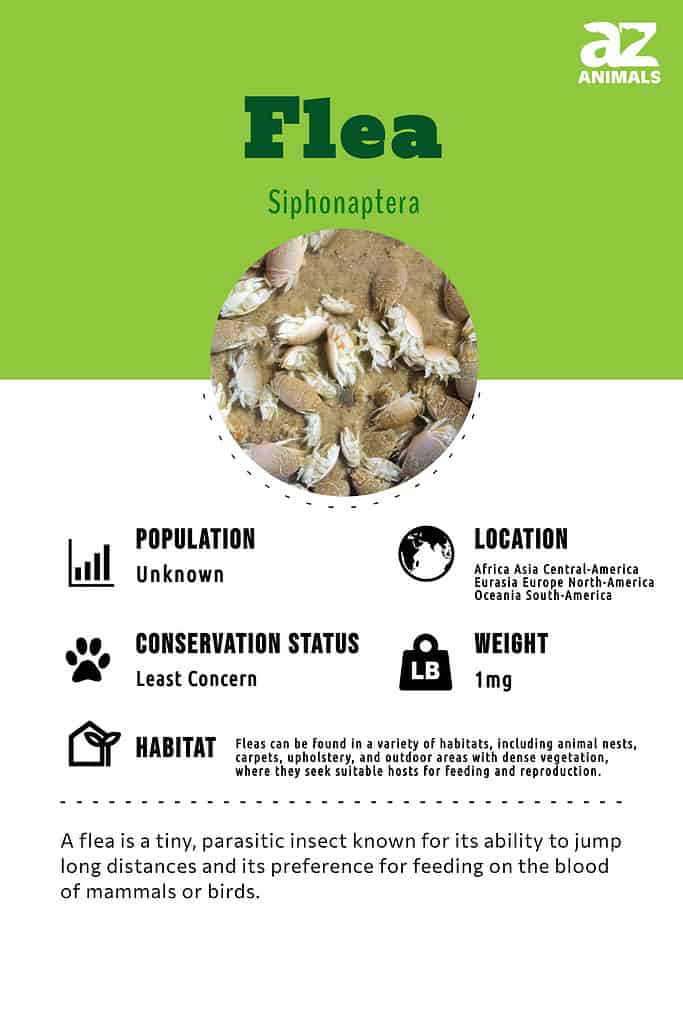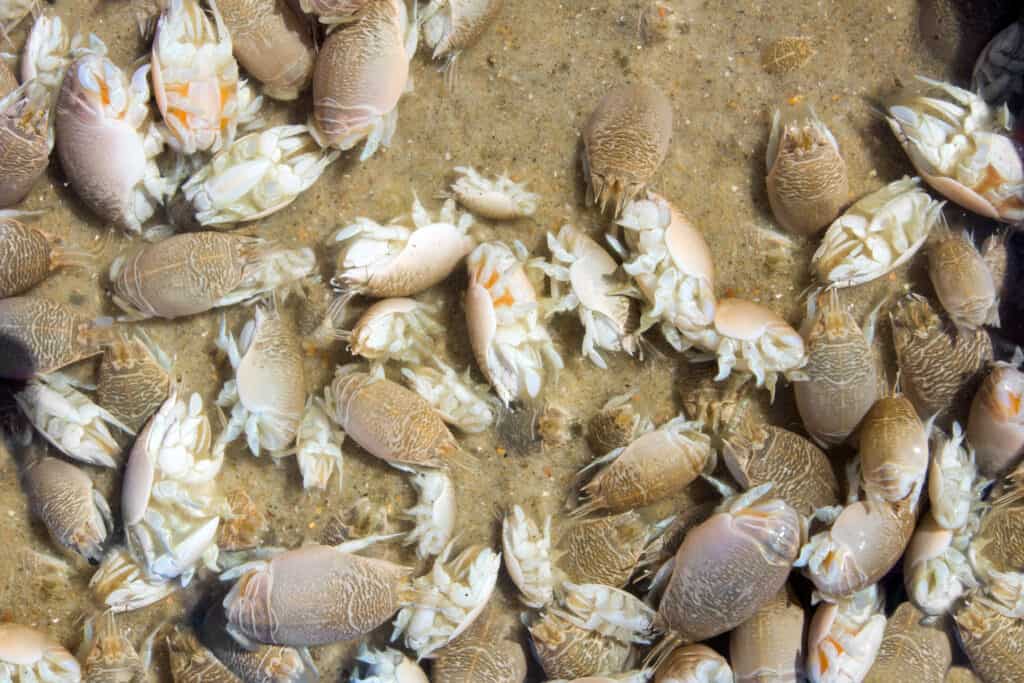Flea
Adult fleas can jump up to 7 inches in the air
Advertisement
Flea Scientific Classification
Read our Complete Guide to Classification of Animals.
Flea Conservation Status
Flea Facts
- Name Of Young
- Larvae
- Group Behavior
- Solitary
- Fun Fact
- Adult fleas can jump up to 7 inches in the air
- Estimated Population Size
- Unknown
- Biggest Threat
- None
- Most Distinctive Feature
- The long legs
- Gestation Period
- A week
- Litter Size
- 25-40 eggs per day
- Habitat
- Mammal and bird hosts in various habitats
- Predators
- Insects, spiders, lizards, snakes, and frogs
- Diet
- Carnivore
- Favorite Food
- Blood and other organic matter
- Type
- Insect
- Common Name
- Flea
- Number Of Species
- 1998
- Location
- Worldwide

Fleas are tiny blood-sucking insects that live on the external body of a host.
They are a constant annoyance for cat and dog owners; more than a billion dollars is spent every year on treatment. While their bites generally cause nothing more than itching and pain, they have been known to transmit diseases to people. They were largely responsible for the transmission of the bubonic plague from rats to humans in the Middle Ages. People can also develop allergies to repeated bites. Fleas normally take avian or mammalian hosts, but some species infest reptiles as well. This article will cover some interesting facts about the identification, prevention, habitat, and diet of the common flea.
3 Incredible Flea Facts!

Fleas possess exceptional resilience, potentially evolving mechanisms to endure substantial pressures exerted by their hosts in attempts to crush them.
©IrinaK/Shutterstock.com
- Fleas are extremely tough. They may have evolved to withstand immense pressures when the host tries to crush them.
- Fleas pass through four different life stages: eggs, larvae, pupas, and adults. The larval stage involves a series of three molts to grow progressively larger, while during the pupa stage, they weave a silk cocoon to transform into an adult. It takes about three to four weeks to reach the adult stage. They can live anywhere between two months and a year.
- One of the most interesting facts is that fleas can leap up to 7 inches vertically and 13 inches horizontally. Given their small size, it’s one of the most impressive jumpers relative to body size in the entire animal kingdom.
Evolution and Origins
As per the study authors, fleas, contrary to common assumption, are taxonomically classified as scorpionflies. Their evolution can be traced back to the period between the Permian and Jurassic, approximately 290 to 165 million years ago when they began to feed on the blood of vertebrates.
It is believed that modern fleas likely originated in the southern region of the Gondwana supercontinent and subsequently migrated swiftly toward the north.
Their evolution is thought to have initially occurred in association with mammalian hosts, with the transition to avian hosts happening at a later stage.
Species, Types, and Scientific Names

The flea order is scientifically known as Siphonaptera, which originates from the fusion of two Greek terms: “siphon,” referring to their tube-like blood-sucking apparatus, and “apteros,” indicating their lack of wings.
©Cosmin Manci/Shutterstock.com
The scientific name for the flea order is Siphonaptera. This is derived from the combination of two Greek words: siphon, meaning tube (their blood-sucking apparatus), and apteros, meaning wingless. There are an estimated 2,000 species spread across more than 240 genera. Some of the most common types include cat fleas, bird fleas, and rat fleas.
Here are the most common:
- Cat flea
- Dog flea
- Human flea
- Chigoe flea
- Ceratophyllidae
- Pulicidae
- Oriental rat flea
- Ischnopsyllidae
- Hectopsyllidae
- Ctenophthalmidae
Appearance: How to Identify Them
Fleas are small wingless insects, rarely measuring more than an eighth of an inch long. The small size can sometimes make identification difficult, but adults are characterized by black or brown bodies, bulbous or rounded at the back, with hard plates and various hairs and bristles directed backward. A long proboscis emerging from the mouth enables them to pierce the skin and suck the blood of its host. Their long legs are well-adapted for jumping and are also covered in strong claws that grasp the host’s body. Brown or black fleas often turn a shade of red after sucking up blood.
The larvae, by contrast, look nothing like the adult. They have a long segmented worm-like body with short bristles instead of legs, no eyes, and mouthparts adapted for chewing. When the larva grows large enough to transform, it will often seek out dark spaces anywhere in the house or on the ground and then weave its cocoon. Some species can actually delay their development until they sense a host nearby. Vibrations, body heat, or carbon dioxide exhaled from a nearby animal are often triggers for the pupa to emerge from the cocoon and attach to the host.

©iStock.com/S.Rohrlach
Habitat: Where to Find Them
Fleas are found in almost all ecosystems around the world. As mentioned previously, they live on the body of a host. Some species are specialized for a specific host (like a cat or a rabbit), while others will accept multiple hosts.
Find out if fleas die in the winter in this article.
Diet: What Do Fleas Eat?
Fleas rely completely on their host for their diet. The host provides nearly all of the organic matter they need to survive.
What eats the flea?
Fleas are often preyed upon by other insects, spiders, lizards, snakes, and frogs.
What does the flea eat?
The adult flea feeds exclusively on blood; the technical term for a blood-feeding animal is hematophage. They typically have 10 to 15 blood feedings per day. The larvae, on the other hand, feed on skin flakes, dead mites, dried excrement, blood, and other bits of organic matter. The pupa does not usually eat at all until it emerges from the cocoon.
Prevention: How to Get Rid of Them

The primary route for fleas to invade households is typically through pets serving as hosts, making it crucial for both cat and dog owners to be particularly watchful for indications of infestation within their homes.
©iStock.com/Jaimie Tuchman
Fleas are most likely to enter the home by taking a pet as a host. Both cat and dog owners should be especially vigilant for signs of infestation in the house. In order to treat your pet, a veterinarian will recommend either an oral insecticide in capsule or tablet form or a topical insecticide applied between the shoulder blades. This should kill adult fleas or prevent them from reproducing for about a month.
Once your pet has received its treatment, you should use a powerful vacuum or steam cleaner on the bedding, carpets, floors, and upholstery every day (especially where you know your pet has been) for several weeks. The vacuum bag should be disposed of immediately after each use to prevent the fleas from immediately returning. Wash the infested bedding in hot water and dry it at the highest possible heat setting.
Finally, you can use an aerosol spray (preferably not a fogger) to ensure any remaining fleas are killed. Chemicals like permethrin normally work for adults, while methoprene or pyriproxyfen will work as a form of pest control for the egg, larva, or pupa stage. Pets can pick up fleas from your yard, so make sure there isn’t any tall grass or debris where the insects can hide (they do not usually stay in exposed areas). Check the area where your pet has just been around the yard. Employing all of these strategies at once will help with the prevention of any future infestations.
View all 91 animals that start with FFlea FAQs (Frequently Asked Questions)
Are fleas dangerous?
Fleas usually pose little more than an annoyance for both pets and people (except in very rare cases of an extreme reaction). What makes them dangerous is that they can spread pathogens and parasites to other animals.
How many legs does the flea have?
It has six legs like any other insect. These legs are highly adapted for jumping.
How do you identify fleas?
Identification can be difficult because of its small size. But brown or black fleas, which look like specks from afar, can be found clinging to your pet’s fur or jumping around in the house.
How do you get rid of fleas?
Fleas are very resilient, which makes pest control difficult. If your pet is infested with fleas, then the first step is to always treat the animal with vet-approved medication. Then you should clean any infested areas as thoroughly as possible.
What do flea bites look like?
Flea bites kind of look like small red dots with a halo around them. They normally appear in clusters around the feet and ankles. The bites are easy to mistake for a mosquito, but the main difference is that they tend to be much smaller than a mosquito bite. Swelling, pain, redness, and itching can occur because of the allergic reaction from the saliva injected into the bloodstream. The saliva prevents blood from clotting so it can suck up as much as possible.
What do flea eggs look like?
The eggs are very small, white, and oval-shaped. Small brown or black fleas normally lay 25 to 40 eggs per day on a pet.
How do you know if you have fleas?
For cat or dog owners, the first sign of an infestation is that the pet will usually start scratching or biting its own skin. You may also notice small bites on pets or family members.
Do fleas live on humans?
Yes, they can live on humans, but people are not a preferred host because of our relative hairlessness. There is one theory that humans evolved hairlessness in part to prevent skin-based parasites from easily attaching, but this has never been proven.
Can fleas live in the bed?
Fleas will sometimes take up temporary residence in the bed, but this is not their preferred habitat, because they do require a living host to survive for longer periods of time. If you do find fleas in the bed, then consider washing the sheets thoroughly or replacing them altogether.
Will fleas go away on their own?
Fleas will go on reproducing if you let them. They should be treated immediately with proper pest control.
What are the differences between fleas and ticks?
The key differences between fleas and ticks include size, appearance, behavioral characteristics, and how they move.
Thank you for reading! Have some feedback for us? Contact the AZ Animals editorial team.
Sources
- Britannica, Available here: https://www.britannica.com/animal/flea
- Terminix, Available here: https://www.terminix.com/blog/bug-facts/all-about-fleas/
- Health Line, Available here: https://www.healthline.com/health/healthy-home-guide/how-to-get-rid-of-fleas

















